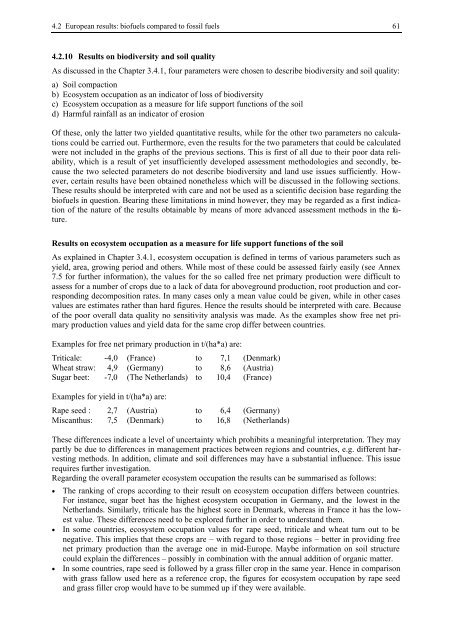BIOENERGY FOR EUROPE: WHICH ONES FIT BEST?
BIOENERGY FOR EUROPE: WHICH ONES FIT BEST?
BIOENERGY FOR EUROPE: WHICH ONES FIT BEST?
You also want an ePaper? Increase the reach of your titles
YUMPU automatically turns print PDFs into web optimized ePapers that Google loves.
4.2 European results: biofuels compared to fossil fuels 61<br />
4.2.10 Results on biodiversity and soil quality<br />
As discussed in the Chapter 3.4.1, four parameters were chosen to describe biodiversity and soil quality:<br />
a) Soil compaction<br />
b) Ecosystem occupation as an indicator of loss of biodiversity<br />
c) Ecosystem occupation as a measure for life support functions of the soil<br />
d) Harmful rainfall as an indicator of erosion<br />
Of these, only the latter two yielded quantitative results, while for the other two parameters no calculations<br />
could be carried out. Furthermore, even the results for the two parameters that could be calculated<br />
were not included in the graphs of the previous sections. This is first of all due to their poor data reliability,<br />
which is a result of yet insufficiently developed assessment methodologies and secondly, because<br />
the two selected parameters do not describe biodiversity and land use issues sufficiently. However,<br />
certain results have been obtained nonetheless which will be discussed in the following sections.<br />
These results should be interpreted with care and not be used as a scientific decision base regarding the<br />
biofuels in question. Bearing these limitations in mind however, they may be regarded as a first indication<br />
of the nature of the results obtainable by means of more advanced assessment methods in the future.<br />
Results on ecosystem occupation as a measure for life support functions of the soil<br />
As explained in Chapter 3.4.1, ecosystem occupation is defined in terms of various parameters such as<br />
yield, area, growing period and others. While most of these could be assessed fairly easily (see Annex<br />
7.5 for further information), the values for the so called free net primary production were difficult to<br />
assess for a number of crops due to a lack of data for aboveground production, root production and corresponding<br />
decomposition rates. In many cases only a mean value could be given, while in other cases<br />
values are estimates rather than hard figures. Hence the results should be interpreted with care. Because<br />
of the poor overall data quality no sensitivity analysis was made. As the examples show free net primary<br />
production values and yield data for the same crop differ between countries.<br />
Examples for free net primary production in t/(ha*a) are:<br />
Triticale: -4,0 (France) to 7,1 (Denmark)<br />
Wheat straw: 4,9 (Germany) to 8,6 (Austria)<br />
Sugar beet: -7,0 (The Netherlands) to 10,4 (France)<br />
Examples for yield in t/(ha*a) are:<br />
Rape seed : 2,7 (Austria) to 6,4 (Germany)<br />
Miscanthus: 7,5 (Denmark) to 16,8 (Netherlands)<br />
These differences indicate a level of uncertainty which prohibits a meaningful interpretation. They may<br />
partly be due to differences in management practices between regions and countries, e.g. different harvesting<br />
methods. In addition, climate and soil differences may have a substantial influence. This issue<br />
requires further investigation.<br />
Regarding the overall parameter ecosystem occupation the results can be summarised as follows:<br />
• The ranking of crops according to their result on ecosystem occupation differs between countries.<br />
For instance, sugar beet has the highest ecosystem occupation in Germany, and the lowest in the<br />
Netherlands. Similarly, triticale has the highest score in Denmark, whereas in France it has the lowest<br />
value. These differences need to be explored further in order to understand them.<br />
• In some countries, ecosystem occupation values for rape seed, triticale and wheat turn out to be<br />
negative. This implies that these crops are – with regard to those regions – better in providing free<br />
net primary production than the average one in mid-Europe. Maybe information on soil structure<br />
could explain the differences – possibly in combination with the annual addition of organic matter.<br />
• In some countries, rape seed is followed by a grass filler crop in the same year. Hence in comparison<br />
with grass fallow used here as a reference crop, the figures for ecosystem occupation by rape seed<br />
and grass filler crop would have to be summed up if they were available.

















